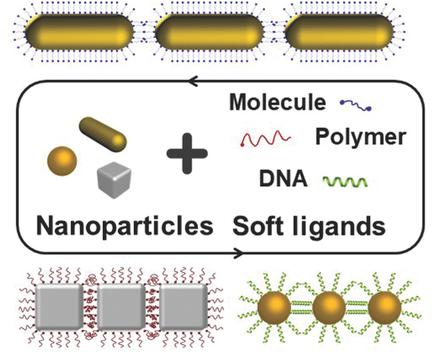Our official English website, www.x-mol.net, welcomes your
feedback! (Note: you will need to create a separate account there.)
Nanoparticle Superlattices: The Roles of Soft Ligands
Advanced Science ( IF 14.3 ) Pub Date : 2017-09-06 , DOI: 10.1002/advs.201700179 Kae Jye Si 1, 2 , Yi Chen 3 , Qianqian Shi 1, 2 , Wenlong Cheng 1, 2
Advanced Science ( IF 14.3 ) Pub Date : 2017-09-06 , DOI: 10.1002/advs.201700179 Kae Jye Si 1, 2 , Yi Chen 3 , Qianqian Shi 1, 2 , Wenlong Cheng 1, 2
Affiliation

|
Nanoparticle superlattices are periodic arrays of nanoscale inorganic building blocks including metal nanoparticles, quantum dots and magnetic nanoparticles. Such assemblies can exhibit exciting new collective properties different from those of individual nanoparticle or corresponding bulk materials. However, fabrication of nanoparticle superlattices is nontrivial because nanoparticles are notoriously difficult to manipulate due to complex nanoscale forces among them. An effective way to manipulate these nanoscale forces is to use soft ligands, which can prevent nanoparticles from disordered aggregation, fine‐tune the interparticle potential as well as program lattice structures and interparticle distances – the two key parameters governing superlattice properties. This article aims to review the up‐to‐date advances of superlattices from the viewpoint of soft ligands. We first describe the theories and design principles of soft‐ligand‐based approach and then thoroughly cover experimental techniques developed from soft ligands such as molecules, polymer and DNA. Finally, we discuss the remaining challenges and future perspectives in nanoparticle superlattices.
中文翻译:

纳米粒子超晶格:软配体的作用
纳米粒子超晶格是纳米级无机构件的周期性阵列,包括金属纳米粒子、量子点和磁性纳米粒子。这种组装体可以表现出与单个纳米颗粒或相应的块体材料不同的令人兴奋的新集体特性。然而,纳米颗粒超晶格的制造并非易事,因为纳米颗粒之间存在复杂的纳米级力,因此非常难以操纵。操纵这些纳米级力的有效方法是使用软配体,它可以防止纳米颗粒无序聚集,微调颗粒间电势以及编程晶格结构和颗粒间距离——控制超晶格特性的两个关键参数。本文旨在从软配体的角度回顾超晶格的最新进展。我们首先描述基于软配体的方法的理论和设计原理,然后全面介绍从分子、聚合物和 DNA 等软配体开发的实验技术。最后,我们讨论了纳米粒子超晶格中剩余的挑战和未来的前景。
更新日期:2017-09-06
中文翻译:

纳米粒子超晶格:软配体的作用
纳米粒子超晶格是纳米级无机构件的周期性阵列,包括金属纳米粒子、量子点和磁性纳米粒子。这种组装体可以表现出与单个纳米颗粒或相应的块体材料不同的令人兴奋的新集体特性。然而,纳米颗粒超晶格的制造并非易事,因为纳米颗粒之间存在复杂的纳米级力,因此非常难以操纵。操纵这些纳米级力的有效方法是使用软配体,它可以防止纳米颗粒无序聚集,微调颗粒间电势以及编程晶格结构和颗粒间距离——控制超晶格特性的两个关键参数。本文旨在从软配体的角度回顾超晶格的最新进展。我们首先描述基于软配体的方法的理论和设计原理,然后全面介绍从分子、聚合物和 DNA 等软配体开发的实验技术。最后,我们讨论了纳米粒子超晶格中剩余的挑战和未来的前景。











































 京公网安备 11010802027423号
京公网安备 11010802027423号